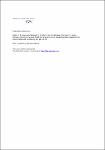Primary snoring in school children: prevalence and neurocognitive impairments.
Brockmann, Pablo E.
Urschitz, Michael S.
Schlaud, Martin
Poets, Christian F.
Purpose: We aimed to investigate the prevalence of primary snoring (PS) and its association with neurocognitive impairments. Methods: Data from a community-based study in 1,114 primary school children were used to identify children who never (N = 410) or habitually snored (N = 114). In order to separate children with PS from those with upper airway resistance syndrome (UARS) or obstructive sleep apnoea (OSA), home polysomnography was conducted in all habitually snoring children. Neurocognitive impairments and poor school performance were compared between children who never snored, PS, and UARS/OSA. Results: Polysomnography was successfully conducted in 92 habitual snorers. Of these, 69 and 23 had PS and UARS/OSA, respectively. Prevalence [95% confidence interval (95% CI)] of PS was 6.1% (4.5–7.7). Compared to children who had never snored, children with PS had more hyperactive (39% vs. 20%) and inattentive behaviour (33% vs. 11%), as well as poor school performance in mathematics (29% vs. 16%), science (23% vs. 12%), and spelling (33% vs. 20%; all P values
No license information

